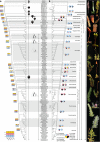Resolution of the ordinal phylogeny of mosses using targeted exons from organellar and nuclear genomes
- PMID: 30940807
- PMCID: PMC6445109
- DOI: 10.1038/s41467-019-09454-w
Resolution of the ordinal phylogeny of mosses using targeted exons from organellar and nuclear genomes
Abstract
Mosses are a highly diverse lineage of land plants, whose diversification, spanning at least 400 million years, remains phylogenetically ambiguous due to the lack of fossils, massive early extinctions, late radiations, limited morphological variation, and conflicting signal among previously used markers. Here, we present phylogenetic reconstructions based on complete organellar exomes and a comparable set of nuclear genes for this major lineage of land plants. Our analysis of 142 species representing 29 of the 30 moss orders reveals that relative average rates of non-synonymous substitutions in nuclear versus plastid genes are much higher in mosses than in seed plants, consistent with the emerging concept of evolutionary dynamism in mosses. Our results highlight the evolutionary significance of taxa with reduced morphologies, shed light on the relative tempo and mechanisms underlying major cladogenic events, and suggest hypotheses for the relationships and delineation of moss orders.
Conflict of interest statement
The authors declare no competing interests.
Figures


References
-
- Cardona-Correa C, et al. Peat moss–like vegetative remains from ordovician carbonates. Int. J. Plant Sci. 2016;177:523–538. doi: 10.1086/686242. - DOI
-
- Goffinet B, Buck WR. The evolution of body form in bryophytes. Annu. Plant Rev. 2013;45:51–89.
-
- La Farge-England C. Growth form, branching pattern, and perichaetial position in mosses: cladocarpy and pleurocarpy redefined. Bryologist. 1996;99:170–186. doi: 10.2307/3244546. - DOI
Publication types
MeSH terms
LinkOut - more resources
Full Text Sources
Other Literature Sources

